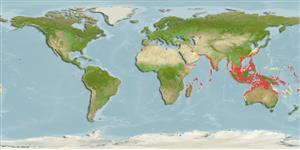分类 / Names
俗名 | 同种异名 | Catalog of Fishes(属, 种) | ITIS | CoL | WoRMS | Cloffa
Teleostei >
Eupercaria/misc (Various families in series Eupercaria) >
Lutjanidae (Snappers) > Lutjaninae
Etymology: Lutjanus: Malay, ikan lutjan, name of a fish.
More on authors: Bloch & Schneider.
Environment: milieu / climate zone / depth range / distribution range
生态学
海洋; 半咸淡水 礁区鱼类; 深度上下限 12 - 100 m (Ref. 55). 熱帶; 33°N - 33°S, 43°E - 178°W
Indo-West Pacific: Persian Gulf and Arabian Sea to Fiji, north to southern Japan, south to Australia. This species has been frequently misidentified as Lutjanus sanguineus (Ref. 55). There are unsubstantiated reports of this species from off East Africa.
印度-西太平洋: 波斯灣與阿拉伯海到斐濟, 北至日本南部, 南至澳洲。 這種曾經時常被誤鑑成 Lutjanus sanguineus 。 (參考文獻 55) 有來自外海的東非的這種的未證實的報告。
Length at first maturity / 大小 / 重量 / 年龄
Maturity: Lm 57.6, range 54 - ? cm
Max length : 100.0 cm TL 雄鱼/尚未辨别雌雄; (Ref. 55); common length : 50.0 cm TL 雄鱼/尚未辨别雌雄; (Ref. 55); 最大体重: 7.9 kg (Ref. 4699); 最大年龄: 31 年 (Ref. 46527)
背棘 (总数) : 11; 背的软条 (总数) : 12 - 14; 臀棘: 3; 臀鳍软条: 8 - 9. This species is distinguished by the following characters: body relatively deep; greatest depth 2.2-2.8 in SL; mouth large, maxilla length about equal to distance between bases of
last dorsal- and anal-fin rays; preopercular notch and knob poorly developed; vomerine tooth patch crescentic or triangular, without a medial posterior extension; gill rakers of first gill arch 4-7 + 12-14 = 18-20 (including rudiments); caudal fin truncate. Colour of back and sides red or red-orange, lighter on lower parts; fins reddish; juveniles with a broad, oblique band of brown or black from upper jaw to beginning of dorsal fin, and a prominent black band across caudal peduncle with a pearly white anterior border, similar to L. timorensis but without the black pectoral-fin axil; young also with a series of narrow reddish horizontal lines (sometimes absent) on sides (Ref. 9821, 90102).
头部的背面轮廓非常陡峭。 眶前骨比眼直径宽许多。 前鳃盖骨凹槽与疖瘤发展不良的。 鳞片列背面斜向上升在侧联机面。 稚鱼有宽,褐色或黑色的斜纹, 从上颌到背鳍起点; 一条突出的黑色条纹横越尾梗具有一个珍珠色到白色的边缘。 在侧边上幼鱼有水平线。 附注: (TL, 公分)=0.28+1.26;(SL, 公分) n=1034.(参考文献 1450)
Adults inhabit both coastal and offshore reefs. They tend to be associated with sponge and gorgonian-dominated habitats on the North West Shelf (Ref. 28006), and hard mud areas of the Arafura Sea. In Australia, they frequently form mixed shoals with L. erythropterus. Juveniles tend to inhabit shallow inshore waters and larger fish live in deeper waters (Ref. 27260, 27264). Juveniles also occur in mangrove areas and seagrass beds (Ref. 128523). Feed mainly on fishes, with small amounts of benthic crustaceans, cephalopods and other benthic invertebrates (Ref. 6390). They forage mostly at night (Ref. 6390). Caught mainly with handlines, bottom longlines, and bottom trawls (Ref. 9821). Marketed fresh, dried-salted (Ref. 55) and frozen (Ref. 9987).
栖息于海岸的与外海礁石。 他们倾向在西北大陆架 (参考文献 28006) 上伴随着海绵与柳珊瑚占优势的栖息地, 与阿拉弗拉海的坚硬泥区域。 在澳大利亚,他们时常形成把浅滩和 L. erythropterus 混合在一起。 稚鱼倾向栖息于沿岸浅水区水域,而且较大的鱼生活于较深的水域。 (参考文献 27260,27264) 主要捕食鱼, 藉由少量的底栖甲壳动物, 头足类动物与其他的底栖无脊椎动物。 (参考文献 6390) 他们大部份觅食在晚上。 (参考文献 6390) 在市场上销售生鲜地了, 乾燥盐腌 (参考文献 55) 与冷冻.(参考文献 9987)
Are batch or serial spawners (Ref. 28009).印度-西太平洋: 波斯灣與阿拉伯海到斐濟, 北至日本南部, 南至澳洲。 這種曾經時常被誤鑑成 Lutjanus sanguineus 。 (參考文獻 55) 有來自外海的東非的這種的未證實的報告。
Allen, G.R., 1985. FAO Species Catalogue. Vol. 6. Snappers of the world. An annotated and illustrated catalogue of lutjanid species known to date. FAO Fish. Synop. 125(6):208 p. Rome: FAO. (Ref. 55)
人类利用
渔业: 高经济性; 游钓鱼种: 是的; 水族馆: 商业性
工具
特别资料
下载 XML
网络资源
Estimates based on models
Preferred temperature (Ref.
123201): 23.8 - 28.6, mean 27.5 °C (based on 745 cells).
Phylogenetic diversity index (Ref.
82804): PD
50 = 0.5000 [Uniqueness, from 0.5 = low to 2.0 = high].
Bayesian length-weight: a=0.01549 (0.01377 - 0.01742), b=2.97 (2.95 - 2.99), in cm total length, based on LWR estimates for this species (Ref.
93245).
营养阶层 (Ref.
69278): 4.5 ±0.5 se; based on diet studies.
Generation time: 6.1 (4.2 - 8.7) years. Estimated as median ln(3)/K based on 24
growth studies.
回复力 (Ref.
120179): 低的, 最小族群倍增时间4.5 - 14 年 (K=0.12-0.18; tmax=12; Fec=5,000,000).
Prior r = 0.17, 95% CL = 0.11 - 0.25, Based on 1 full stock assessment.
Fishing Vulnerability (Ref.
59153): High vulnerability (60 of 100).
Climate Vulnerability (Ref.
125649): Very high vulnerability (88 of 100).
Nutrients (Ref.
124155): Calcium = 18.9 [11.4, 28.8] mg/100g; Iron = 0.279 [0.178, 0.460] mg/100g; Protein = 18.8 [17.3, 20.2] %; Omega3 = 0.134 [0.092, 0.196] g/100g; Selenium = 69.5 [40.5, 114.1] μg/100g; VitaminA = 179 [31, 733] μg/100g; Zinc = 0.374 [0.285, 0.518] mg/100g (wet weight); based on
nutrient studies.
